Explainer
The Uluru Statement from the Heart outlines the path forward for recognising Indigenous Australians in the nation's constitution.
It was endorsed with a standing ovation by a gathering of 250 Aboriginal and Torres Strait Islander leaders on May 26, 2017, following a four-day First Nations National Constitutional Convention held at Uluru.
The consultation process that led to the statement was unprecedented in Australian history for its scale. A Referendum Council, appointed by then-prime minister Malcolm Turnbull and recently departed Labor leader Bill Shorten, was tasked with charting the next steps for constitutional reform in 2015. Over a six month period, it engaged more than 1200 Aboriginal and Torres Strait Islander representatives in a dozen regional dialogues across the country.
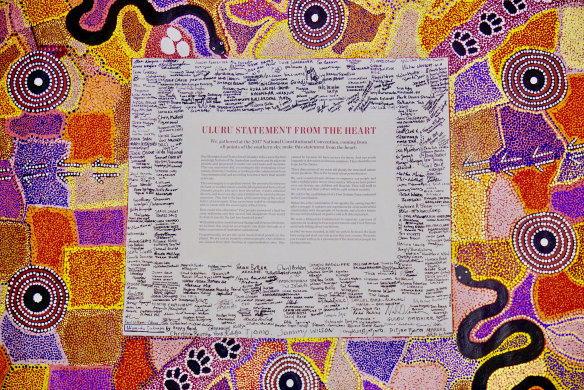
The Uluru Statement is addressed to the Australian public. Credit: Fairfax Media
Those discussions culminated with Indigenous Australians "from all points of the southern sky" reaching a consensus position on constitutional recognition for the first time.
The statement itself is 12 paragraphs and has been noted for its succinct and powerful wording.
Unlike historic documents of Indigenous aspirations that came before it and were addressed to the Parliament, the Uluru Statement from the Heart is directed to the Australian public.
It asks Australians to change the constitution to allow Indigenous Australians a voice in the laws and policies that are made about them.
Throughout the consultations, delegates overwhelmingly rejected symbolic recognition in the form of a simple acknowledgement in the constitution, as had been advanced by the "Recognise" campaign. The statement instead lays out their vision for substantive and structural reform that will make a difference in their communities.
What is the Voice?
The Uluru Statement proposes three key elements for sequential reform:"Voice, Treaty, Truth". The first and most significant of these is the Voice: the proposal for a First Nations Voice to Parliament enshrined in the constitution.
This would be an advisory body of First Nations traditional owners to advise Parliament on policy affecting Aboriginal and Torres Strait Islander people. The Voice would offer a way to include Indigenous Australians' cultural authority in matters of law that affect them, and constitutionally guarantees them a say in their own affairs.
The precise model for the Voice - including whether its members are elected or selected - has yet to be designed. The Morrison government has set aside funds for a "co-design" process to take place with First Nations leaders. However, proponents of the idea have suggested the Voice would sit separately to Parliament and its advice would not be binding.
The Australian constitution must be amended to allow Parliament to legislate for such a body.
The statement's second recommendation is a Makarrata Commission. "Makarrata" is a concept belonging to the Yolngu people in Arnhem Land, and means to come together after a struggle to heal divisions of the past.
Since the 1980s, "Makarrata" has frequently been used as an alternative term to "treaty". A Makarrata commission would oversee agreement making between the Australian government and Indigenous people, and facilitate the statement's final proposal: truth-telling.
What does the artwork mean?
The Uluru Statement is an artwork as well as a political document, following in the tradition of documents such as the Yirrkala Bark Petition and Barunga Statement.
The artwork was led by senior Maruku artist and Uluru traditional owner Rene Kulitja, and painted by Mutitjulu artists Christine Brumby, Charmaine Kulitja and Happy Reid.
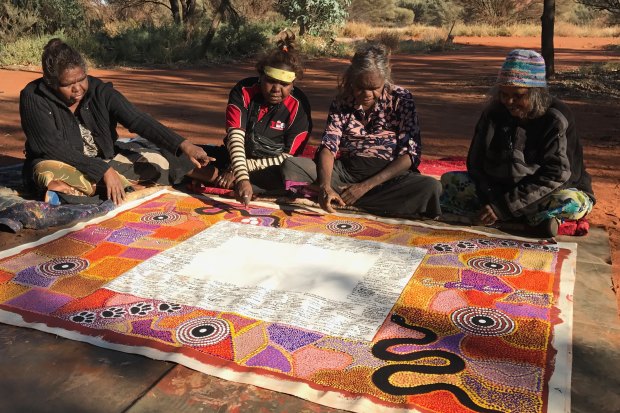
Lead artist Rene Kulitja (third from left) supervises artists Christine Brumby, Charmaine Kulitja and Happy Reid. Credit: Clive Scollay
Two Tjukurpa creation stories of the Anangu people, who are the traditional owners of Uluru, are represented in the painting.
One is the story of Kuniya (top left), the woma python with eggs from the north-east, and Liru (bottom right), the poisonous snake from the south-west, who are involved in a fight to the death at the Mutitjulu Rockhole, which then shapes Uluru's landscape.
The second is that of the Mala people, represented by rufous hare-wallaby prints, who were holding a ceremony atop Uluru when they became involved in a dispute with men who approached from the west. Those men went away and created Kurpany, the Devil Dingo, represented by the dog prints.
Ms Kulitja said Uluru's power comes from the Tjukurpa stories that converge there. "This painting shows all the stories of Uluru and the statement is placed at the centre where the power resides," she said.
Surrounding the statement are signatures of more than 250 delegates who came to historic consensus at Uluru. Many signatories also wrote the name of the nation they belonged to, so over 100 different first nations are represented on the artwork.
Who are the key people involved?
Megan Davis, a Cobble Cobble woman and constitutional law expert, gave the Uluru Statement its first public reading at a ceremony after the convention. She was a member of the 16-person Referendum Council and led much of its work, presenting its final report to Parliament in June 2017. She also sat on Julia Gillard's 2010 expert panel on constitutional recognition.
Human rights advocate and Alyawarre woman Pat Anderson was co-chair of the Referendum Council and a key spokesperson, consulting with hundreds of Indigenous people to deliver the statement. She has worked as an administrator in Indigenous health, authored the Bringing Them Home Report on the Stolen Generations, and was last year honoured with the NAIDOC Lifetime Achievement Award.
Lawyer and activist Noel Pearson has long lobbied for recognition, consulting with parliamentarians and constitutional conservatives to navigate what reform could look like. His Cape York Institute, a public policy organisation, has been instrumental in mapping and advocating possibilities for changing the constitution.
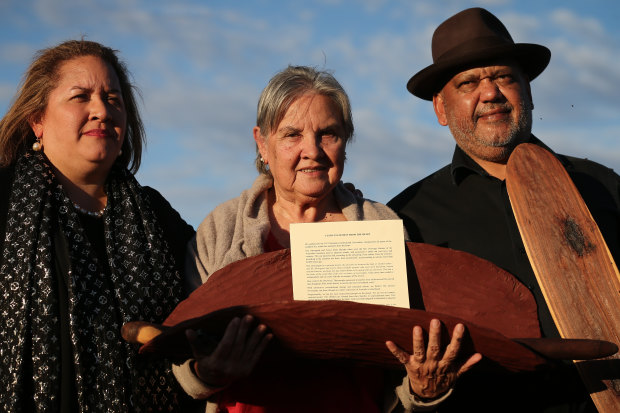
Megan Davis, Pat Anderson and Noel Pearson with a piti holding the Uluru Statement from the Heart.Credit: Alex Ellinghausen
Ms Davis, Ms Anderson and Mr Pearson were principal designers of the constitutional dialogues that delivered the Uluru Statement, but many other Indigenous Australians will be prominent in pushing the campaign forward.
Wangkumarra and Barkindji man Sean Gordon is a businessman and chair of non-profit organisation Uphold & Recognise. He quit the Liberal Party in 2017 over Malcolm Turnbull’s rejection of the statement.
Sydney lawyer Teela Reid, a Wiradjuri and Wailwan woman, has emerged as a key community voice advocating for the Statement. She challenged Turnbull's rejection on ABC's Q&A in 2017 and has cautioned against watering it down.
Torres Strait islander Thomas Mayor toured Australia's cities and bush communities with the statement for 18 months and spoke with over 10,000 people in his attempt to generate grassroots support.
Western Australian MP Ken Wyatt, a Noongar, Yamatji and Wongi man, has been vocal in his support. He has been the Coalition government's only Indigenous minister as the country heads toward a referendum.
What were key landmarks on the way to the statement?
A number of representative bodies, political protests, petitions and broken promises precede the Uluru statement. The following highlights key moments leading to the historic consensus reached in May 2017.
1937 Yorta Yorta elder William Cooper collects 1800 signatures to petition King George VI for Aboriginal representation in federal Parliament.
January 26, 1938 The Aboriginal Progressive Association holds a "Day of Mourning" in Sydney to protest the "callous" treatment of Aboriginal Australians and demand full citizen status and equality.
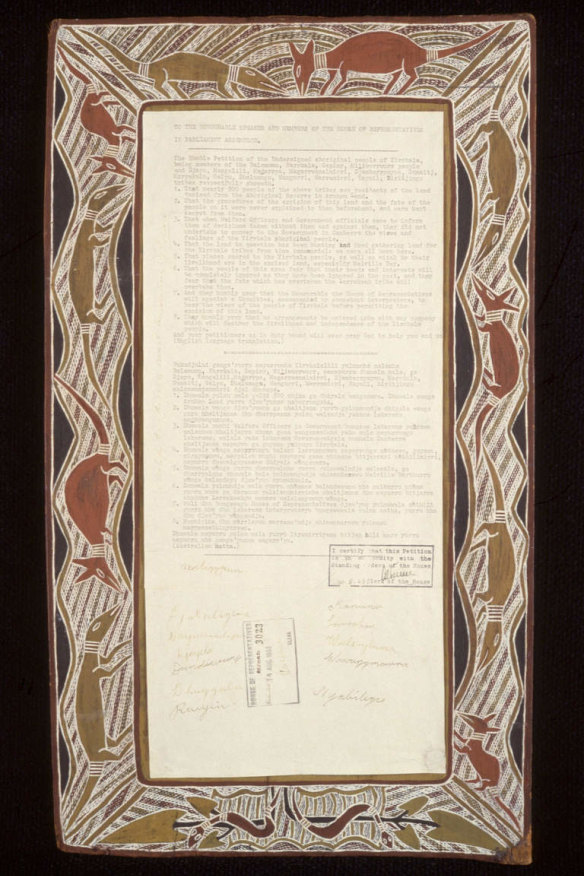
The Yirrkala Bark Petition, presented in 1963.Credit: Yirrkala artists.
February 13, 1958 Aboriginal lobby groups form the Federal Council for Aboriginal Advancement, which becomes the first united national body for Aboriginal interests. They begin a 10-year campaign to change the constitution.
June 18, 1962 Indigenous people gain the vote in Commonwealth elections. By the end of 1965, all Indigenous people have equal voting rights after Queensland extends state voting rights to Indigenous people.
August 14, 1963 The Yolngu people from Arnhem Land present the federal government with the Yirrkala bark petition, in response to mining leases taken out on their traditional lands. The petition combines bark painting with typed text and is the first traditional document to be recognised by Australian Parliament.
February 12, 1965 Indigenous student Charles Perkins leads freedom rides through towns in north-western NSW to expose discrimination against Aboriginal people.
May 27, 1967 Over 90 per cent of Australians vote "yes" in a referendum that allows the federal government to make laws for Aboriginal people and enables their inclusion in the national census.
January 26, 1972 The Aboriginal Tent Embassy in Canberra begins with four men crouched under a large beach umbrella in the rain, protesting the Liberal party's policy on land rights.
October 20, 1972 One thousand Aboriginal people sign the three-metre long Larrakia Petition calling for land rights, and it is posted to Queen Elizabeth.
April, 1979 The National Aboriginal Conference, established in 1973, resolves a treaty should be made between Aboriginal people and the federal government. It uses the Yolngu word "Makarrata" for the process and sets up a special committee.
June 12, 1988 Labor prime minister Bob Hawke is presented with the Barunga Statement, a painted declaration of Aboriginal aspirations on a 1.2-metre-square sheet of wood. He responds by calling for a treaty to be negotiated.
March 5, 1990 The Aboriginal and Torres Strait Islander Commission (ATSIC) is established as a government body to represent Indigenous people, elected by Indigenous people.
April 15, 1991 The Royal Commission into Aboriginal Deaths in Custody presents its report, recommending a formal process of reconciliation between Indigenous and non-Indigenous Australia be undertaken.
June 3, 1992 The High Court's Mabo decision rejects 'terra nullius' and recognises the existence of native title.
February 6, 1995 The ATSIC report Recognition, Rights and Reform says constitutional reform is a priority and finds overwhelming support for recognising Indigenous Australians in the constitution.
May 27-28, 2000 A gathering of Indigenous people present prime minister John Howard and the Governor-General with a "Roadmap for Reconciliation". The next day, over 250,000 people walk across the Sydney Harbour Bridge to show support for reconciliation in the largest political demonstration held in Australia.
March 24, 2005 ATSIC is abolished following corruption investigations.
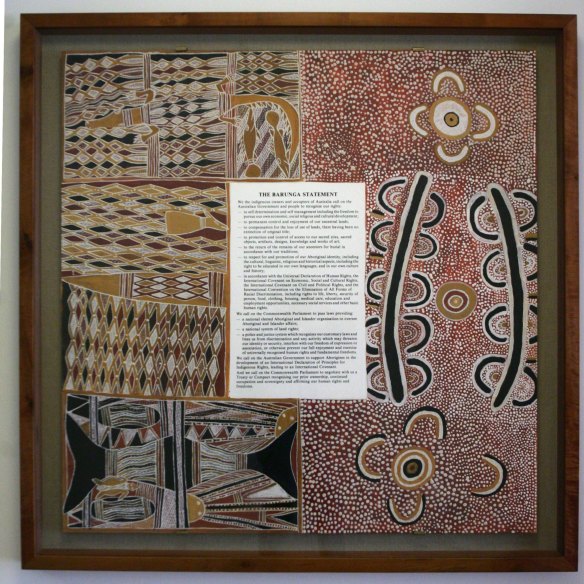
The Barunga Statement, presented to prime minister Bob Hawke in 1988.Credit: Andrew Taylor
October 16, 2007 Howard pledges to hold a referendum on constitutional recognition for Indigenous Australians and Labor leader Kevin Rudd promises bipartisan support.
February 13, 2008 Labor prime minister Kevin Rudd says "Sorry" to the Stolen Generations for damage caused by government policies.
November 8, 2010 Prime minister Julia Gillard announces plans for a referendum to acknowledge Indigenous Australians in the constitution.
December 7, 2015 The Referendum Council is jointly appointed by prime minister Malcolm Turnbull and Labor leader Bill Shorten to advise on next steps for a referendum.
May 23-26, 2017 Over 250 Aboriginal and Torres Strait Islander delegates gather at Uluru to craft the Uluru Statement from the Heart, which is an historic consensus position on Indigenous constitutional recognition.
Let us explain
If you'd like some expert background on an issue or a news event, drop us a line at explainers@smh.com.au or explainers@theage.com.au. Read more explainers here.